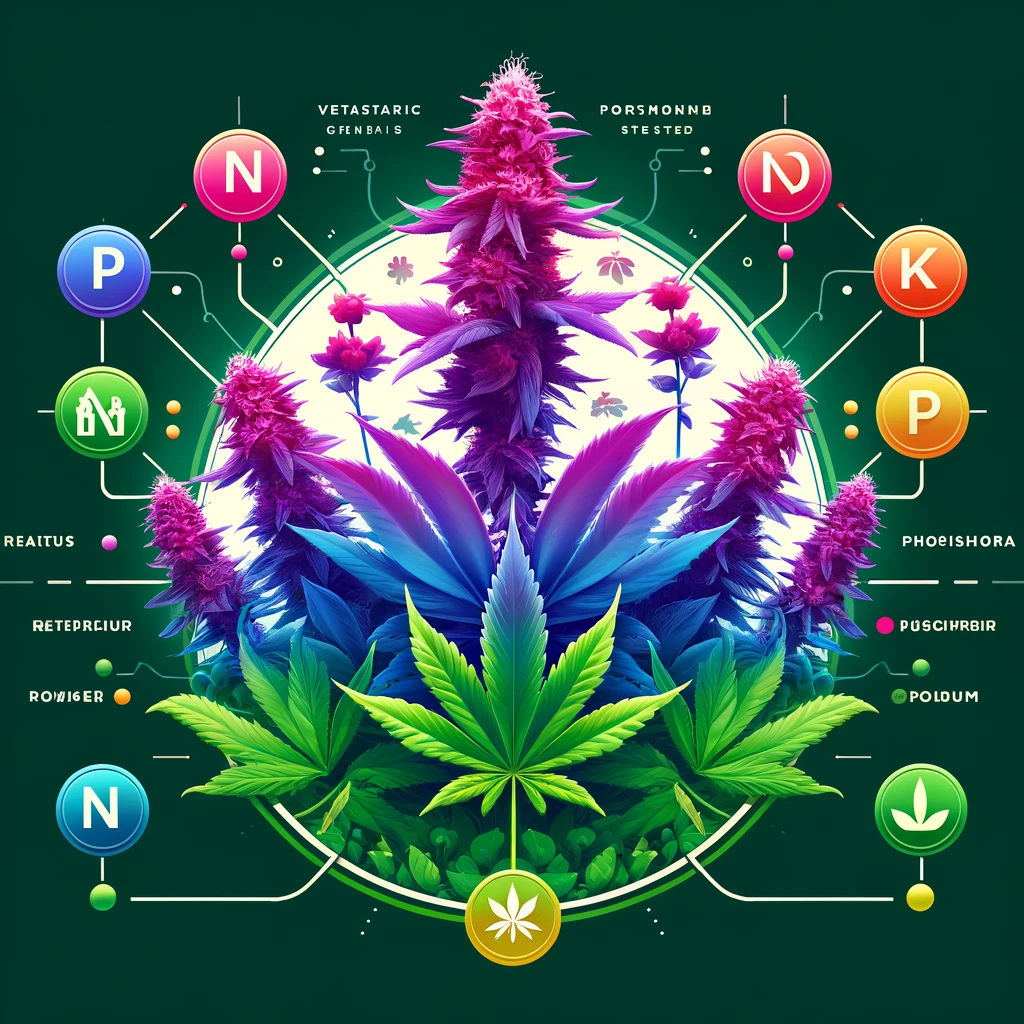The main three nutrients are nitrogen (N), phosphorous (P) and potassium (K) and they will be denoted by the NPK formula on the side of your nutrient bottle. Secondary nutrients are Calcium, Sulfur and Magnesium. In trace quantities, boron, copper, molybdenum, zinc, iron, and manganese.

Understanding the Flowering Stage
The flowering stage in cannabis begins when the light cycle is adjusted to 12 hours (or more) of darkness. The flowering stage typically lasts between 8 and 10 weeks, depending on the strain. During this time, the plant’s nutritional needs change significantly from the veg stage.
Primary Nutrients:
- Nitrogen (N): While necessary, the need for nitrogen reduces as the focus shifts from leaf growth to bud development. Too much nitrogen can negatively impact flower growth and strength.
- Phosphorus (P): Becomes important during flowering as it aids in the formation of buds. A boost in phosphorus can encourage bigger and denser buds.
- Potassium (K): Essential for the overall health of the plant, potassium helps with photosynthesis, nutrient uptake, and strengthens cell walls which help support the heavy buds that we always expect.
Secondary Nutrients:
- Calcium (Ca) and Magnesium (Mg): Both are needed for healthy cellular processes and structural development of the plant. Calcium plays a role in cell wall development, while magnesium is crucial for chlorophyll production.
- Sulfur (S): Important for protein synthesis and enzyme activity, sulfur also contributes to the plant’s terpene profiles.
Micronutrients and Their Importance
Micronutrients are also essential for the well-being of your flowering cannabis plant:
- Iron, Manganese, Boron, Zinc, Copper, and Molybdenum each play specific roles ranging from chlorophyll formation to enzyme support. Deficiencies in these can lead to stunted growth and poor flower development.

Feeding Methods
If feeding by hand and using dry nutrients, mix them the day before in very hot water to dissolve and let cool overnight. If using tap water, leave the top off to evaporate some of the chlorine. If using premixed liquid nutrients then skip this step.
Most hydroponic solutions should be in the range of 150-600 parts per million in dissolved solids. 300-400 ppm is optimum. It is possible to test your solution or soil with a electrical conductivity meter if your unsure of what your giving your plants.
Keep in mind most dissolved solids readings are usually on the low side, and actual nutrient levels are usually higher. It’s possible with hydroponics, to get nutrient build-up over several feedings, to the point the medium is over saturated in nutrients. Just feed straight water now and again, until you notice the plants are not as green (slightly), then resume normal feeding.
Changing Nutrient Needs
Your plant will still need all of the same nutrients that you were giving it in the vegetative stage, however the ratios will differ greatly. When flowering your plants will require higher amounts of phosphorous and potassium instead of the nitrogen heavy feed you gave them early on in the vegetative stage.
Any fertilizer that is labelled bloom will be beneficial for your plant during the flowering stage. By lowering the amount of nitrogen that you are feeding your plants you will ensure that the plant in question does not waste energy producing more leaves, the increases levels of potassium and phosphorous will ensure your cannabis plant has thick colas and flowers.
Advanced Tips for Enhanced Flowering
Adding bloom boosters that contain extra phosphorus and potassium will increase bud size. Additionally, introducing molasses and other supplements like amino acids can improve resin production and flavor.
Common Issues
In the latter phase of flowering (approx week 10-13) your buds will start to pack on mass. Marijuana can be very fussy so be very aware of any clues she gives as to nutrient deficiencies. A sure-sign of ‘nute-burn’ or overfeeding is the appearance of brown leaf tips anytime during the nutrient cycle. In the next few weeks the bottom leaves of the cannabis plant will start to turn yellow in color. This is normal and not a sign of a nutrient deficiency.
Rather than processing new minerals through the roots, the plant saves energy for budding by feeding on itself. You should reduce feeding at this time from half to 25% of normal. Once the pistils turn rust-colored and the trichomes start changing from clear to milky it is time to stop feeding altogether and only give your girls pure water. This will flush your plants of any excess nutrients and give you a cleaner smoke.
Conclusion
The flowering stage is a critical period when growing and requires careful attention to your nutrients. By providing the right nutrients at the right time, you can significantly increase the quality and quantity of your final harvest.
FAQs
Q: How often should I feed my flowering cannabis plants? A: Feeding schedules depend on the medium and the plant’s health. Typically, nutrient solutions are given every other watering to prevent buildup in the medium.
Q: Can I use vegetative nutrients during the flowering stage? A: It’s best to switch to a flowering formula as vegetative nutrients are high in nitrogen, which is less needed during this stage and can negatively affect bud growth.
Oregon Is The Best State For Stoners


